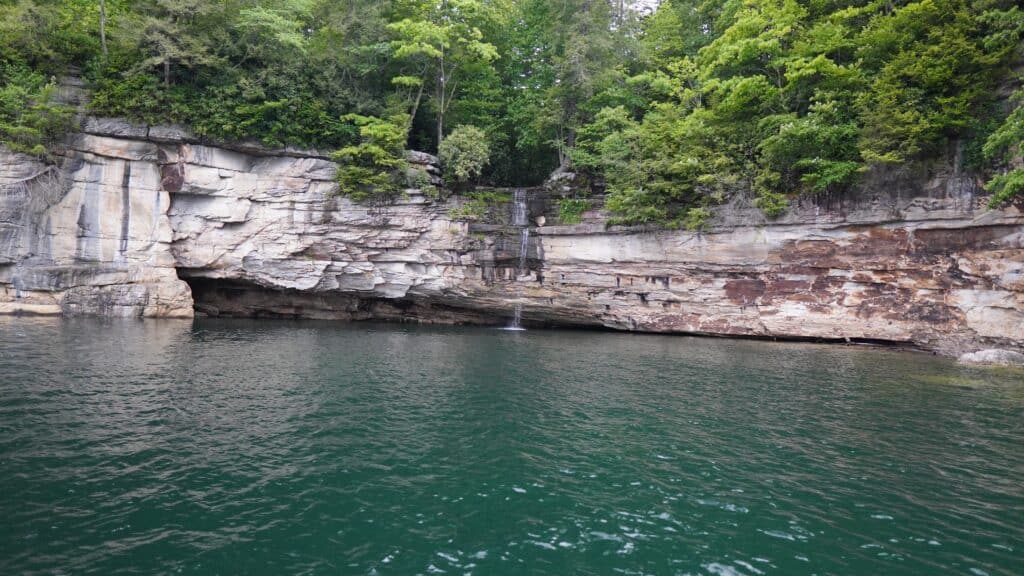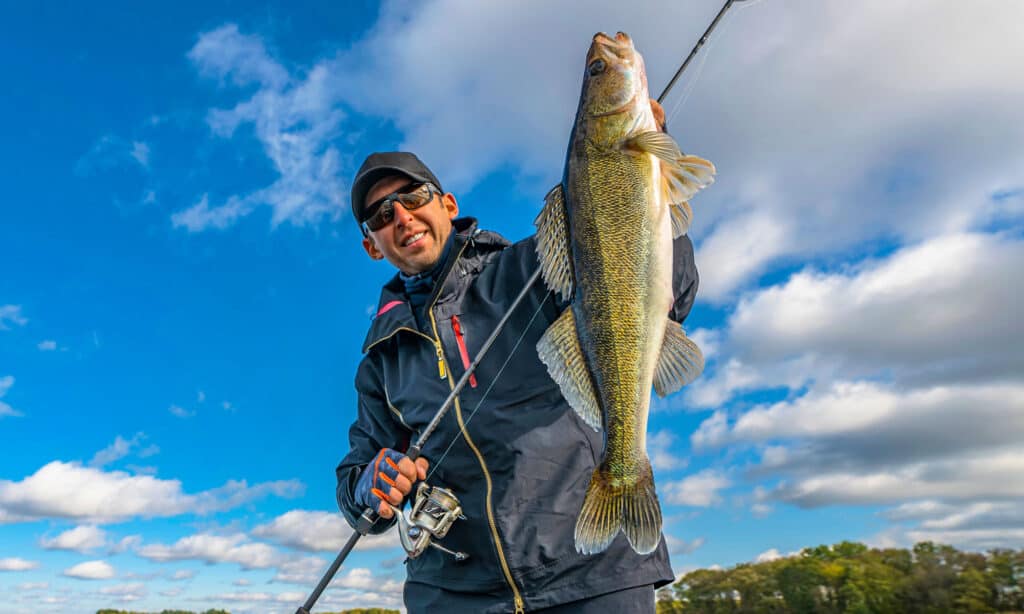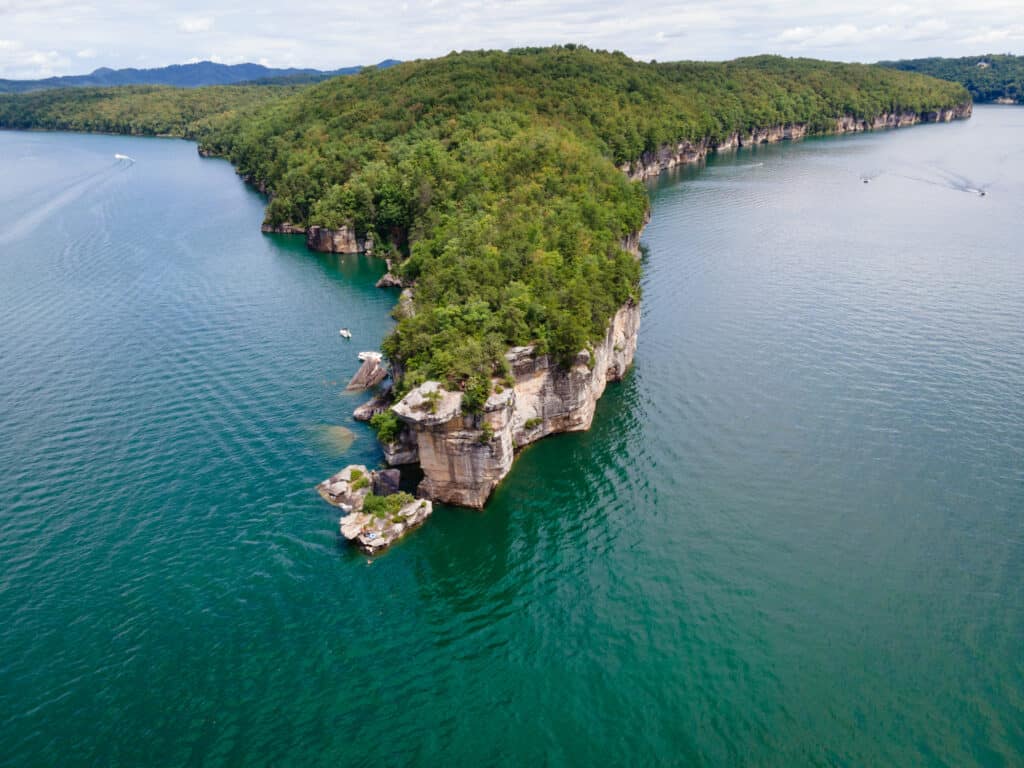Summersville Lake is the largest lake in West Virginia. Because of its incredible water quality and gorgeous sandstone cliffs, Summersville Lake is a favored destination for outdoor fun. From boating to scuba diving, there’s plenty to do at this lake. Let’s discover all of Summersville Lake’s features, including fishing, size, depth, and more.
Where Is Summersville Lake Located?

Summersville Lake, West Virginia, has the nickname “The Little Bahamas of the East.”
©Dylon Beamer/Shutterstock.com
Located in the south-central part of the state, Summersville Lake is on the Gauley River. Situated in Nicholas County, West Virginia, Summersville Lake is just south of the city of Summersville. Also, the 5,974-acre Summersville Lake Wildlife Management Area (WMA), which is on the north end of the lake, overlooks the gorgeous expanse of water. The Summersville Lake WMA has a large plateau of forests and stunning cliffs, which give you the perfect view of the lake.
How Big Is Summersville Lake?
Summersville Lake has a surface area of 2,700 acres. With 60 miles of shoreline and a maximum depth of 327 feet, it’s no wonder Summersville Lake is the biggest lake in West Virginia.
The History of the Lake

The Summersville Dam is the second-largest of its kind in the United States.
In 1960, the United States Army Corps of Engineers started construction on the Summersville Dam, which impedes the Gauley River, creating Summersville Lake. It was for the purpose of controlling flooding along the Gauley River and Kanawha River.
The dam is the largest dam in West Virginia, standing at 390 feet tall and 2,280 feet long. The USACE constructed the dam as a rock-fill dam, dumping compacted rock fill and an impermeable concrete layer to keep water from seeping through. Using 12,000,000 cubic yards of rock and dirt, the Summersville Dam is the second-largest of its kind in the United States.
In 1966, the dam and lake were completed. Then, in 1999, the USACE started building a two-unit hydroelectric powerhouse at the Summersville Dam. Completed in 2001, this powerhouse generates 217 million kilowatt-hours per year. That’s enough power for over 50,000 homes.
Fishing at Summersville Lake
With 60 miles of shoreline and an area of 2,700 acres of water, Summersville Lake is the perfect place for anglers to spend the day. In fact, record-breaking fish, like this 41.2-inch long carp, have been caught in Summersville Lake!
As a favored fishing location, Summersville Lake is a place where you can catch walleye, trout, common carp, largemouth bass, and more!
Walleye

Walleye is a favored game fish among fishermen because it is a very lean freshwater fish.
©FedBul/Shutterstock.com
This fish gets its name from its opaque-looking eyes. Their eyes appear cloudy and pearlescent, which is caused by the tapetum lucidum, or reflective pigment layer, behind the retina. This allows the walleye to see and feed in low light or murky water.
Walleye is a favored game fish among fishermen because it is a very lean freshwater fish. With a low level of bones and a light, buttery flavor, Walleye are among one of the finest-tasting freshwater fish. Because of this, they are very popular game fish.
The biggest walleye caught in West Virginia was from the Kanawha River, very close to Summersville Lake. That walleye measured 17 pounds and 0.82 ounces and was 32 inches long. Steve Skeens caught this mammoth walleye in 2003.
Trout

Rainbow trout and brown trout are the most common kinds found in Summersville Lake.
©Paul Winterman/Shutterstock.com
Most commonly found in rivers, streams, and lakes with plentiful oxygen levels and abundant vegetation, trout are another popular freshwater fish to catch. They have long, oval bodies with relatively small heads and eyes. Most species of trout are dark with silver scales along the sides.
Classified as oily fish, trout fillets may contain up to 30 percent oil. This means they are rich in omega-3 fatty acids and Vitamins A and D. This is extremely helpful for inflammatory conditions and heart health.
Rainbow trout and brown trout are the most common kinds found in Summersville Lake. Rainbow trout average 20 to 30 inches in length and weigh around eight pounds. And brown trout are typically seven to 14 inches long and weigh about five pounds.
Common Carp

The common carp was introduced to the U.S. as a sport fish in the 19th century.
©Vladimir Wrangel/Shutterstock.com
Also classified as an oily freshwater fish, carp may be found seeking shelter in weedy or muddy bottoms of lakes, rivers, or ponds. Introduced in the 19th century as sport fish, the common carp quickly spread through the waterways, and by the 20th century, it was considered an invasive species.
Because of their fast growth rate, they can out-compete most native fish. And, because carp are filter feeders, they feast on the base of the aquatic food chain, creating food scarcity for those up the chain.
But, some anglers are drawn to carp because of their size and abundance. Such is the case with the record-breaking carp Ayden Minick caught in Summersville Lake. At 41.2 inches long and 45 pounds, that is a mammoth fish to catch.
Largemouth Bass

Compared to most fish in the sunfish family, largemouth bass grow quite large.
©Pierre Rebollar/Shutterstock.com
Because the corner of its mouth extends past its eye, this bass is understandably named “largemouth!” Ranging in color from forest green to olive, dark bands run along the sides of the largemouth bass. While they are a part of the sunfish family, largemouth bass have thicker, less “flattened” bodies compared to most sunfish. And compared to most fish in the sunfish family, largemouth bass grow quite large. On average, largemouth bass are 12-15 inches long and weigh 12 pounds or more.
The largemouth bass is generally on the top of the food chain. Young bass must fear being eaten by larger fish such as the northern pike, muskies, and even adult largemouth bass. But, once they reach maturity, very few animals prey on this bass besides bald eagles and humans.
Outdoor Recreation at Summersville Lake

Summersville Lake is the largest lake in West Virginia, with 60 miles of shoreline and a surface area of more than 2,700 acres.
©Malachi Jacob’s/Shutterstock.com
Boating
Summersville Lake is a gorgeous location for an afternoon of boating. Several locations offer boat rentals—from pontoons to outboard motor boats. Or, you may bring your own! You may utilize the launch ramps at Battle Run, Salmon Run, Long Point Area, and Picnic Area for just a five-dollar day-use fee. Enjoy water skiing, tubing, and white water rafting along Summersville Lake.
Swimming
A popular beach spot around Summersville Lake is at Battle Run Area. People may enjoy swimming or scuba diving at this location. Because of the water clarity, many people enjoy scuba diving throughout the lake. However, note that there are no lifeguards are duty, so be sure to be safe while exploring the waters.
Camping
While random camping is prohibited around Summersville Lake, you may certainly enjoy a weekend of camping at Battle Run Campground. Battle Run is an established campsite with showers, trailer waste disposal facilities, accessible restrooms, parking, and more. Enjoy the beach and fishing opportunities while staying at Battle Run Campground.
In Conclusion

While it provides recreational options, Summersville Lake plays a crucial role in the surrounding area.
©iStock.com/Eifel Kreutz
Summersville Lake is certainly a popular destination for summer recreation in West Virginia. Besides the entertainment the lake provides, Summersville Lake also plays a crucial role in controlling flooding and providing hydroelectric power to the surrounding area. All in all, the largest lake in West Virginia is certainly a prominent place to visit.
Thank you for reading! Have some feedback for us? Contact the AZ Animals editorial team.








